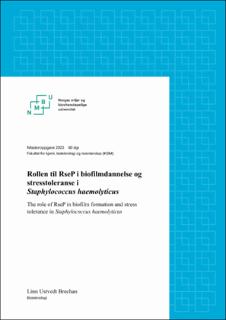| dc.description.abstract | Staphylococcus haemolyticus er en bakterie som er en del av den vanlige hudmikrobiotaen til mennesker. Samtidig er den ofte en årsak til infeksjoner hos mennesker med nedsatt immunforsvar eller personer med medisinske implantater. Blant koagulasenegative stafylokokker er denne arten en av de som oftest isoleres fra kliniske blodprøver. I tillegg til sin evne til å danne biofilm er antibiotikaresistens stadig mer utbredt hos S. haemolyticus, noe som gjør behandling utfordrende. Derfor har bakteriociner blitt undersøkt som en mulig tilleggsbehandling og/eller alternativ til antibiotika i behandling av infeksjoner forårsaket av S. haemolyticus. Spesielt lovende er medlemmer av en familie bakteriociner kalt LsbB familien. Disse bakteriocinene har en enkel og liten struktur, og er derfor relativt enkle å modifisere og syntetisere. Ved hjelp av peptiddesign ble bakteriocinet hybrid 1 (H1) konstruert ved å kombinere sekvenser fra to forskjellige bakteriociner fra LsbB familien. Dette nye konstruerte bakteriocinet er vist å ha spesielt god antimikrobiell aktivitet mot S. haemolyticus.
Bakteriocinet H1 er tenkt å interagere med membranproteinet regulator av sigma-E protease (RseP) for å drepe målcellen, og en mutasjon i dette genet som endrer struktur og/eller interagerende aminosyrer gjør at bakteriocinet ikke lenger fungerer. Funksjonen til RseP i S. haemolyticus er ikke kjent, og det er sett at spontane mutasjoner i rseP genet lett kan oppstå. RseP er kjent å være involvert i blant annet stressrespons, virulens, og biofilmdannelse hos en rekke bakterier, og det antas derfor at resistensutvikling kommer på bekostning av levedyktighet og virulens.
Formålet med dette studiet var å undersøke om S. haemolyticus uten RseP, som er resistente mot H1, hadde redusert motstandsdyktighet, i form av sensitivitet mot ulike kjemiske stoffer og antibiotika. Det ble også undersøkt forskjeller i evnen til å danne biofilm. For å få bedre innsikt i de molekylære mekanismene bak forskjellene ble genuttrykk mellom mutant og villtype av utvalgte gener målt med revers transkripsjon (RT) kvantitativ PCR (qPCR).
I arbeidet ble det isolert muterte stammer av S. haemolyticus resistente mot H1, og sekvensering av disse viste at alle hadde mutasjoner knyttet til rseP. Fenotypiske tester viste at rseP mutantene hadde lavere motstandsdyktighet mot stress og betydelig svekket evne til å danne biofilm. Analyse av genuttrykk viste at villtypen kan respondere på stressende forhold ved å oppregulere srrA og nedregulerer ecsB, noe som ikke ble sett hos rseP mutanten. Det ble også sett at genuttrykk var høyere for mutanten enn det sett for villtypen, noe som tyder på at normalt utrykk av disse genene avhenger av funksjonelt RseP. Disse funnene gir verdifull innsikt i bruken av bakteriocinet H1 til behandling av infeksjoner forårsaket av S. haemolyticus, samt konsekvensene av resistente celler. Videre kan studien bidra til en dypere forståelse av de mekanismene som reguleres av RseP, og hvordan proteinet kan brukes som et antimikrobielt mål. Dette vil kunne ha betydning for utviklingen av nye og mer effektive behandlingsmetoder for infeksjoner forårsaket av S. haemolyticus. | |
| dc.description.abstract | Staphylococcus haemolyticus is a commensal bacterium that is part of the normal skin microbiota of humans. At the same time, it is often a cause of infections in people with weakened immune systems or people with medical implants. Among coagulase-negative staphylococci, this species is one of those most frequently from clinical blood samples. In addition to its ability to form biofilms, antibiotic resistance is becoming more widespread in S. haemolyticus, which makes treatment challenging. Therefore, bacteriocins have been investigated as a possible adjunctive treatment and/or alternative to antibiotics for the treatment of infections caused by S. haemolyticus. Particularly promising are members of a family of bacteriocins called the LsbB family. These bacteriocins are small, have a simple structure and are therefore relatively easy to modify and synthesize. Using peptide design, the bacteriocin hybrid 1 (H1) was constructed by combining sequences from two different bacteriocins from the LsbB family. This new engineered bacteriocin has been shown to have particularly good antimicrobial activity against S. haemolyticus.
The bacteriocin H1 has been thought to interact with the membrane protein regulator of sigma-E protease (RseP) to kill the target cell, and mutations in this gene that change the structure and/or interacting amino acids render cells resistant to the bacteriocin. The function of RseP in S. haemolyticus is not well understood, and it has been observed that spontaneous mutants of rseP can arise easily. RseP is known to be involved in, among other functions, stress response, virulence, and biofilm formation in several species, and it is therefore likely that resistance carry a fitness cost, such as reduced fitness and virulence.
The aim of this study was to investigate whether S. haemolyticus with mutated RseP, which is resistant to H1, had increased susceptibility to various chemical substances and antibiotics. Differences in the ability to form biofilms were also investigated. To gain better insight into the molecular mechanisms behind the differences, gene expression between mutant and wild type of selected genes was measured by reverse transcroption quantitative PCR.
In the work, S. haemolyticus strains resistant to H1 were isolated, and sequencing of these showed that all had a mutation associated with rseP. Phenotypic tests showed that rseP mutants had lower resistance to stress and a significantly reduced ability to form biofilm. Analysis of gene expression showed that the wild type can respond to stressful conditions by upregulating srrA and downregulating ecsB, which was not observed for the rseP mutant. It was also noted that gene expression was higher for the mutant than that seen for the wild type, which suggests that normal expression of these genes depends on functional RseP. These findings provide valuable insight into the use of the bacteriocin H1 in the treatment of infections caused by S. haemolyticus, as well as the consequences of resistant cells. Further, this study contributes to a deeper understanding of the mechanisms regulated by RseP, and how the protein can be used as an antimicrobial target. This could have an impact on the development of new and more effective treatment methods for infections caused by S. haemolyticus. | |
